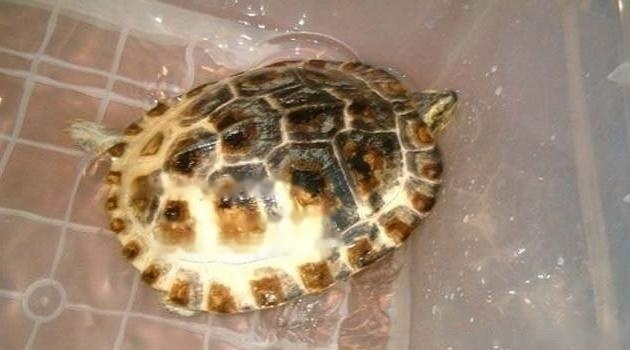The Indian Peacock Turtle, also known as the Indian Marsh Turtle or the Yellow-bellied Marsh Turtle, belongs to the Retort suborder, Turtle family, Aquatic subfamily, and Marsh turtle genus. There are 2 species in this genus, the other is the Burmese marsh turtle, both of which have no subspecies differentiation. The most obvious difference between the two is that the carapace of the Burmese marsh turtle has an obvious central ridge, and there is no white surrounding pattern in each scutellum of the carapace. However, the carapace of the Indian marsh turtle has no obvious ridges, and there are white circles on each scutellum. However, in the pet market, they are often sold together with the spotted marsh turtle as marsh turtle, but the two are not the same species. It is a turtle species found in northeastern India and Bangladesh. It is also distributed in Bihar state in western India, mainly in Southeast Asia, Myanmar, India and other countries. It was named after the German herpetologist Wilhelm Peters (1815-1883).

1. Appearance characteristics of the Indian peacock tortoise
The Indian peacock tortoise is of moderate size, and the adult nail length is generally up to 18 cm about. The head is medium and triangular in shape. The top of the head is black with a thin yellow stripe in the shape of a v. Inlaid on the edge of the top of the head, there are two yellow vertical stripes on the face, extending to the neck. The eyes are large, surrounded by white circles, the peck is brown, the upper peck is slightly defective in the center, and the lower peck is smooth. The carapace has a high bulge, no obvious ridges, black, and the outer edge is yellow. The center of each scutellum has a white circle pattern, and the seams between the scutellum are light yellow. The front and rear edges are smooth and not serrated. The plastron is pale yellow without any markings, so some people call it the yellow-bellied marsh turtle. The limbs are relatively flat, gray-black, and scaly. There are webs between the fingers and toes, and the tail is moderate.
2. Habits and characteristics of Indian peacock turtles
Indian peacock turtles are semi-aquatic turtles, but can live in deep water for a short time. Wild tortoises often inhabit marshes, low-lying areas not far from water, pools and mountain streams. Under artificial feeding conditions, it likes to live in water, and when the temperature is high, it also climbs to the shore to rest. When the ambient temperature reaches 22-25°C, they can eat normally, stop eating at about 18°C, do not move or move less at 15°C, and enter the hibernation state as the temperature gradually decreases. Indian peacock turtles can lay eggs when they weigh about 1000 grams. The spawning season is from April to June each year, with 3 to 4 eggs per litter, but usually only 2. Eggs have a long diameter of 46 to 57 mm and a short diameter of 35 to 57 mm. Eggs weigh 25 to 29 grams.
3. Feeding of Indian Peacock Turtles
【Optional】
Indian Peacock Turtles Sexually timid, most of the time it is in a closed-shell posture, which is difficult to observe. When purchasing, weigh the turtle with your hand. It feels light in the hand, and the shell seems to be empty. Such a turtle should not be purchased; Since the Indian peacock tortoise is a tropical species, the average temperature in winter in the origin is about 15°C, and the hibernation time is short (only from January to February), while the climate in my country is diverse. In winter, the temperature is low and the time is long. Therefore, the purchase time should not be in winter (except the southern region).
【Environment】
The Indian Peacock Turtle is of moderate size, and the adult nail length is generally about 18 cm. A medium-sized glass jar can be used as a rearing container. It is best to cover the bottom of the container with sand. And set up a land for turtles to climb. But be careful. Because Indian peacock turtles can't swim, prolonged exposure to deep water can cause drowning. So the water level in the container should not exceed at most 2/3 of the turtle's height. Under artificial feeding conditions, Indian peacock tortoises like warm and cold, and are very sensitive to temperature changes. When the temperature differs by 5°C in a short period of time, it will cause diseases such as gastritis. Turtles can eat and digest normally when the temperature is above 24°C. The best temperature is between 26-32°C. When the temperature is lower than 16°C, the turtle enters hibernation. However, because the Indian peacock turtle is produced in the subtropical zone, it is best for breeders to heat it to avoid some unexpected situations during the hibernation process.
【Daily】
Under captivity, Indian peacock turtles like to eat cucumbers, tomatoes, bananas, sulfur leaves, zucchini and other plant foods . Occasionally eat a small amount of mealworms, fly maggots and other worms, most individuals do not eat artificial mixed feed. The Indian peacock tortoise has poor adaptability, and the newly purchased tortoise will generally refuse to eat. In addition, when they enter the breeding season, the males are smaller than the females, have a longer and narrower carapace, a thicker tail, and the cloaca is farther from the rear edge of the carapace. The carapace of females is shorter and wider, the tail is thinner and shorter, and the cloaca is far from the rear edge of the carapace.
![[Dog Training 5] The training method of pet dog dining etiquette](/static/img/12192/12192_1.jpg)




